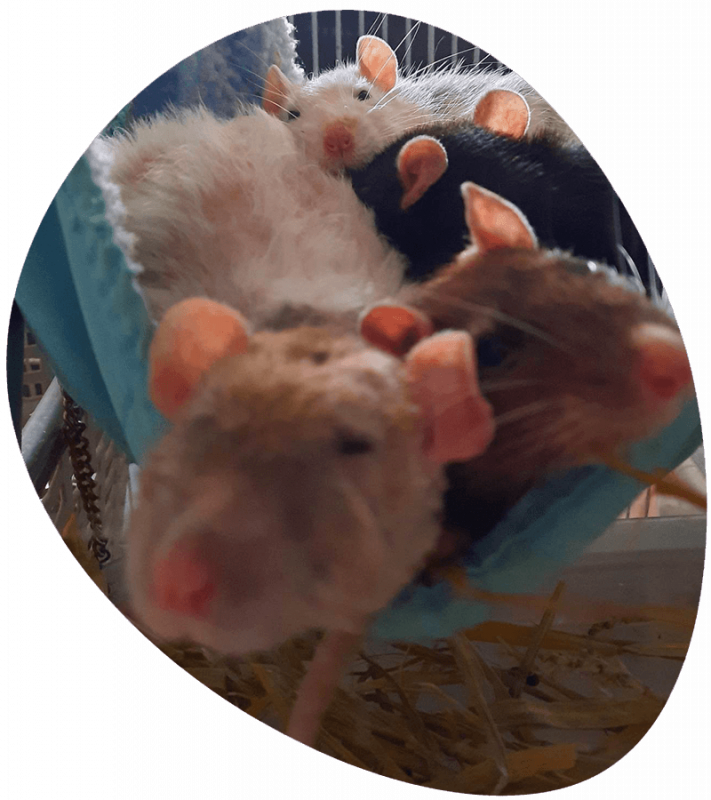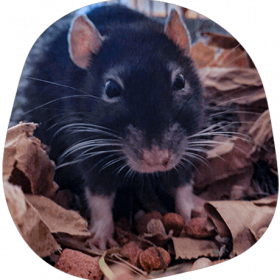Rat care guide!


This basic guide will help you to catch up to speed with proper rat care in no time! However, since we don’t position ourselves to be experts at rat care (but we are experts in rat t-shirts and hoodies!), the guide will also include links to the best of the best rat care information available across the WEB! So let’s dig in, shall we? 🙂

The whole rat community agrees, that rats should be acquired ethically. But what does that mean?
Let’s start with, where not to get rats – from pet shops. Rats in pet shops are generally sourced from rodent mills – unethical businesses, where animals are forced to reproduce in grim conditions for profit. Does are usually pregnant 90% of their life to increase the output. In some cases, diseases run rampant among the rat population in rodent mills. And let’s not even talk about animal abuse happening there.
Buy rattos from ethical breeders! Yes, some breeders might not be better than rodent mills, but there are always passionate and caring breeders that sell healthy and well socialized rats.
Methods of finding ethical breeders will vary depending of country you live in. There are rat breeder associations in many countries, that has a database of breeders, so start digging!
Any rat, adopted from animal shelter or a person that abandons them is by default ethical. You can find adoptable rats by following nearby animal shelters or on social media sites. Luckily, when deciding not to have rats anymore, most people look for new home for them. This will give you extra Karma.
IMPORTANT! Always evaluate your experience with rats. Occasionally, while adopting rats, you can come across unsocialized adult rats, that might be emotionally traumatized or abused. There is no shame in admitting that you can’t help them (yet) and leave them for more experienced rat parent to adopt.
It’s not only the cage that matters, it’s your whole living space!
Rats have a couple of specific needs, which you will need to consider.
Try to make a chill environment, rats can sense your mood, just like dogs and cats can. So, relax and vibe together with rats! 🙂
There are many scary stories online about household chemicals, that can result in severe health problems and even death for rats. Before using any strong chemicals, make sure rats are at least located in another room, and that the area is well-ventilated.
It would be very difficult to provide a list of harmful chemicals, so use common sense when dealing with cleaning agents! If you wouldn’t want it close to your face, it goes for rats as well.
Remember, they are way more sensitive than we are!
They smell fresh, but there’s nothing natural in them. They pose a severe risk of damaging the rat’s respiratory system.
Rats use smell to orient themselves within any given space. Any strong smell can throw them off and make them irritated, even if it doesn’t create any damage to the respiratory system.
It’s recommended to keep the living space free of any fragrances and ventilate regularly!
Excessively loud music or other noises will cause stress, as rats are very sensitive to loud noises! Keep the volume reasonable!
However, rats will get used to the normal noises of your environment, and won’t be scared! You can live as normal! They oftentimes sleep right through music, when it’s not obnoxiously loud! 🙂
There are many lovely videos of rats hanging out with other pets, but just as many stories of inter-species communication going wrong.
Rats are naturally territorial and prey animals at the same time. It’s hard to know exactly how a rat will react to the presence of another pet. This goes the other way around as well!
Make sure rats are safely contained within a cage when other pets are roaming the living space! Also, is the latching system of your cage designed so it can’t be opened by other animals easily?
Let’s start with enclosures not suitable for rats –
More information to the right!
Often times, pet shops will sell enclosures that are too small for rats. Just because rats fit inside, doesn’t mean space is sufficient.
How to calculate if the cage is spacious enough? Use the cage calculator!
Rats love to climb, it’s crucial to choose a cage that allows that – vertically spacious rather than horizontally. So, cages designed for guinea pigs and bunnies are a no-go. Cages designed for chinchillas and ferrets can be considered.
Important: Consider bar spacing. If too wide, young rats will be able to squeeze trough!
Aquariums/Tanks: Glass aquariums don’t provide adequate ventilation, which will lead to poor air quality, and rats can develop respiratory issues in a poorly ventilated environment. Additionally, the glass walls will not allow for proper climbing and exploring.
Wire-bottom Cages: Cages with wire bottoms can cause injury to a rat’s feet and are uncomfortable for them to walk on. They can also lead to conditions like bumblefoot. If the cage is otherwise suitable, the wire floor must be covered with a soft mat, plastic sheet, etc.
Cages intended for guinea pigs or bunnies: Rats love to climb, so it’s crucial to choose a cage that allows that – vertically spacious rather than horizontally. These sorts of low cages can be used as retirement cages for old rats or rats suffering from hind leg degradation.
CritterTrail Habitats: These modular plastic habitats are often too small and lack proper ventilation for rats. They are designed for smaller rodents and will not accommodate the needs of rats.
The more stuff the better! Rats love tight spaces, climbable obstacles, and hideouts. Definitely consider hammocks and sputniks! These sorts of cage designs will enrich the environment for the rats, and improve their quality of life! 🙂
Faithful Rattos - Bioactive rat cageCages with Sharp Edges or Protrusions: Cages with sharp edges or protruding wires can injure rats, so it’s important to choose enclosures with smooth, rounded edges.
Cages with wire shelves: While not necessarily a deal breaker, wire shelves must be disposed of or covered.
Let’s start with bedding not suitable for rats –
More information to the right!
Bedding is not only for absorbing pee, it can be much more! It’s recommended to have a cage with a deep bottom, for rats to be able to dig in the bedding! Alternatively, a concrete mixing tub of similar size can be inserted to create deep bottom. They have an instinct for digging, you just made an enriching activity from just bedding!
Cedar and Pine Bedding: Cedar and pine shavings emit aromatic compounds (phenols) that can be harmful to rats’ respiratory systems. These compounds can lead to respiratory distress and other health problems. Avoid these types of bedding!
Cat Litter or Clumping Clay: Cat litter, especially clumping clay varieties, can be dangerous if ingested by rats. Rats may accidentally ingest litter while grooming, which can cause blockages in their digestive system.
Scented or Perfumed Bedding: Bedding products with added scents or perfumes may irritate a rat’s sensitive respiratory system. It’s best to stick with unscented bedding.
Hay: Very high dust, will cause a lot of sneezing and possible respiratory problems. Very poor absorbency, It’s intended as a food for herbivorous animals, after all.
Straw: In my personal experience, it makes better bedding than hay, but it’s still far from ideal. It’s better used as a nesting material in combination with another type of bedding.
Aspen Shavings: Aspen shavings are a safe alternative to cedar or pine shavings, as they do not contain harmful aromatic oils.
Fleece Liners: Some rat owners use fleece liners for the cage floor. These should be combined with a suitable absorbent layer beneath to help manage moisture.
Paper-Based Bedding: Commercially available paper-based bedding, such as CareFresh or Yesterday’s News, is a popular choice. These are absorbent, virtually dust-free, and safe for rats.
Never put a new rat in with your current rats without quarantine first!
Quarantine is usually in effect for 14 days, it gives you time to determine whether there are any contagious health conditions, that must be addressed before introducing the new rats to the current mischief. Even if a condition isn’t contagious, keep in mind that introductions will cause stress, which can delay the recovery,
There are breeders and animal rescues that quarantine rats before offering them for adoption, so make sure to ask them about it, this could make the process easier for you!
When observing rats during quarantine, look for:
These signs will be explained further in this guide’s “Health section”!
Quarantine will work better if the new rats are quarantined in an entirely different location. If not possible, use a separate room, but make sure to ventilate it well, to lessen the risk of airborne contagion. Make sure to wash your hands after handling each group of rats as well!
If the quarantine is passed without signs of illness, rats are ready for intros!
Rats are very territorial and generally not fond of unfamiliar rats in their turf. Never put a new rat in with your current rats without introducing them safely first!
To better understand introductions, try to imagine yourself as both parties of rats.
The first group just noticed a foreign group of rats on their turf. What do they want? Our food? How many of them are there, is our clan going to be overrun? Are we in danger?
The second group is afraid, brought to the well-established (and pee-marked) territory of another clan against their will. Are we in danger? How do we get away?
There are several methods you can use to introduce them safely and help your rats accept the newbies into their clan! 🙂
This method uses a small space (usually a carrier cage) to introduce the rats safely. The small space doesn’t allow the rats to fight each other and works as an exposure therapy to the presence of another rat group.
After 12 hours with no fights or squeaks passes, all rats must be moved to a slightly larger cage, to allow for a little more movement, but still not too much for them to be able to give chase to each other.
All of the small cages must be equipped with a water bottle! Food must be scattered in the bedding 🙂
AKA The Bathtub Method 😀 This uses neutral space, free of markings by any of the rats. Neutral territory lessens any aggression significantly, allowing the rats to get to know each other, without fighting for territory.
Bathtubs are commonly used for this, since rats aren’t usually free roamed there. If you choose to do this, cover the bottom of the bath with a clean towel, as rats don’t like to walk an cold or moist surfaces.
However, any other neutral space can be used, as long as it’s free from any rat smells.
Rat Randomness - How to Introduce Rats(Neutral Space Method)Before getting rats, it’s very important to find an exotic pet veterinarian near you! Your new rats will need to see a veterinarian, at some point, there is no “if”. However, most health issues in rats can be addressed, so be vigilant!
So save yourself some stress, and find a vet you can turn to before you need to!
Keep in mind, that most veterinarians will only work with common animals like dogs and cats, hence it’s important to find out whether the clinic in question has a vet, specializing in exotic pets working there.
Feeding your pet rat a well-rounded diet is essential for their health and well-being. Rats are omnivorous animals, which means they can eat a variety of foods.
Have Fresh Water always available! Make sure your rat always has access to clean, fresh water. Water should be changed daily, to keep it fresh.

Avoid feeding your rat chocolate, sugary or salty snacks, and any foods that are toxic to rats!
Before introducing new foods, make sure they are safe! What foods are toxic, will differ from animal to animal, as their bodies might not be able to break them down! Just because you can eat it, doesn’t always mean a rat can too!
Rats are prone to obesity, so it’s crucial to control portion sizes and not overfeed them. Obesity can lead to various health issues.
Keep in mind, that a rat will convince you that they are hungry in order to get more food, even though they aren’t even hungry. Don’t fall for this! 😀
Some rats may be sensitive to certain foods. If you notice digestive problems or allergies, consult with a veterinarian to adjust the diet accordingly.
It’s important to choose high-quality rat pellets containing all the necessary base nutrients. Look for pellets specifically intended for rats, not generic rodent pellets, these can have significantly different contents within them. For example, pellets indented for hamsters will have significantly more calories, than rats require.
It’s required to include fresh vegetables, fresh fruits, lean protein sources, grains, and occasional treats alongside pellets.
This is a very popular home-made diet that meets all of the rats dietary requirements!
Faithful Rattos - The Shunamite DietOffer occasional special treats like yogurt drops or bananas (rats have a special love for them!). These should be given sparingly as they are high in fat.
It’s generally agreed that rats should be free-roamed an hour a day. While this is the perfect scenario, what can you do if that’s not possible? You can design a safe enclosure for rats to free roam in, that way you won’t have to babysit them that much and you will be able to do other stuff while rattos are enjoying zoomies!
40 – 60 min would be optimal!
Of course, no rat would ever complain about a longer free roam, so find a compromise between your schedule and the rats’ activity level. When a rat goes to sleep somewhere in a free-roam area, you can just as well put them back in a cage to sleep there 🙂
This generally will be a DIY option, that makes free-roams safer. Designated area is enclosed in a non-climbable (everything is climbable, according to Lara) enclosure for rats to roam in.
This will require less babysitting and allow you to do your stuff, but use your judgment! Make sure that the rats won’t escape it after all.
Shadow The Rat - All About my Rats Free-Range Area (Updated)Dedicate a room or a section of a room to serve as a play area for your rats.
It’s important to rat-proof the space by blocking off small openings, covering electrical cords, and removing any potential hazards. Ensure windows and doors are securely closed to prevent escapes. Remove any toxic plants, chemicals, or substances from the play area, and make sure there are no other pets in the area that could pose a threat to your rats.
Provide a variety of furniture and accessories for exploration and play. This could include cardboard boxes, tunnels, hammocks, and rat-safe climbing structures. Arrange these items strategically to create a stimulating environment! 🙂
Always supervise your rats when they are outside of their cage to ensure their safety and prevent accidents!
Offer a selection of toys and puzzles to keep your rats mentally engaged. Your rats will love puzzle feeders and treat-dispensing toys.
Pet rats will sleep in cyclical pattern (from my observations anyways). This is called polyphasic sleep. This means they will be awake and sleep both during day and night.
Usually they make there sleep depending on your daily routine, and will start their day alongside you. Especially if you give them snacks in the morning! 🙂
Don’t wake them up unnecessarily! Uninterrupted sleep will grant your rats a “Well rested” bonus and decrease stress. It’s also very imporrtant for health!
And don’t worry, noise from your daily activities will be familiar to them and most likely won’t wake them up, so no need to walk on your toes! 🙂
Rats are very good at hiding the fact that there are something wrong with them. And it’s not a joke, sometimes we notice it only when everything is already really bad.
They can even climb the cage with a broken limb like nothing has happened!
This makes it really important for every rat parent to familiarize themselves with general signs of an unwell rat.
Remember that most of the health issues can be helped with by the vet, we just need to identify them quick enough.
Be vigilant!
If a usually calm rat displays aggression or irritability, it’s most likely a sign of ilness.
A rat my also become unusually skittish and try to hide if not feeling well.
A decrease in appetite or a refusal to eat can be a strong indicator that your rat is not feeling well.
Weight loss may also occur. A good way to track it is to perform regular weigh-ins.
An increased thirst can also be a symptom of various illnesses and inflammatory processes.
If a rat is unusually inactive, reluctant to move, or spends most of its time lying down, it may be a sign of illness.
However, this can also indicate lack of activities, free roams and companionship, evaluate carefully!
Rats are usually passionate about keeping their fur clean and well-kept. If that’s not the case, it’s most likely a sign of ilness.
Neurological symptoms include:
Any neurological symptoms must be discussed with a vet! It’s hard to diagnose the condition by yourself because different causes can create the same symptoms. For example: Head tilting can be caused by a zymbal gland tumor, ear infection or a stroke!
URI, is a huge concern in rats.
Symptoms may include sneezing, wheezing, labored breathing, and nasal discharge (Porphyria). Seek veterinary care promptly if you suspect a respiratory infection. Treatment typically involves antibiotics.
URI are often caused by bacteria, most commonly, Mycoplasma pulmonis, carried by almost all pet rats.

Since almost all of the rats carry Mycoplasma pulmonis bacteria when a URI is noticed, it’s important to find out the cause of the flare-up.
URI flare-ups can be caused by:
When the cause of the flare-up is detected, it’s possible to decrease the chance of it happening again in the future!
Ammonia from urine irritates the rat’s respiratory system. Make sure to clean your rat’s cage frequently to prevent ammonia build-up. It’s important to use a bedding that can absorb urine well, to prevent this.
Poor ventilation, high humidity, and overcrowding can contribute to respiratory issues. Ensure that your rat’s cage is adequately ventilated and cleaned regularly to prevent the build-up of ammonia and other irritants.
Optimal humidity: 40-60%
Optimal temperature: 18°C to 26°C / 64°F to 79°F
Don’t smoke or vape indoors when having pet rats! Avoid exposing your rats to secondhand smoke, as it can severely damage their respiratory system!
Stress can weaken a rat’s immune system, making them more susceptible to respiratory infections. Provide a stable and comfortable living environment to minimize stress.
Unfortunately, rats can develop various types of cancer and benign tumors, including mammary gland tumors, skin tumors, pituitary tumors, lung tumors, and more. The frequency and types of tumors can vary depending on factors like genetics, age, and environmental conditions, however, they still remain common.
Unfortunately, not all of the tumors can be removed or even detected without an ultrasound. This makes it important to pay attention to signs of illness, discussed earlier in this guide.
If a tumor is found, It’s crucial to consult a vet, to determine whether a growth can be removed or not.
In some cases, cancer in rats may not be treatable or curable. In such situations, the focus may shift to providing palliative care to improve the rat’s quality of life. This can involve pain management, supportive care, and efforts to ensure the rat is comfortable and free from distressing symptoms.
Unfortunately, some cases of cancer in rats may progress to a point where further treatment is not viable, and euthanasia may be considered to prevent suffering. This is a difficult decision but may be necessary for the welfare of the rat.
Did you know that rat’s incissors grows for 8mm (0.315 inches) every month! That’s the reason why they won’t get any cavities in those! They grind them constantly to keep them sharp! However, rat’s do have second type of teeth – molars. Those are not used for gnawing, but for chewing the food. Molars don’t grow, so it’s important to keep them healthy!

How do I know my rat’s teeth are healthy?
Overgrown incisors (front teeth) are a common issue in rats. If a rat’s teeth do not wear down naturally through chewing on hard objects, they can become too long and lead to difficulty eating and other health problems.
Malocclusion occurs when the upper and lower incisors do not meet properly. This misalignment can result in uneven wear of the teeth, leading to overgrowth of some teeth and undergrowth of others.
Rats may break their teeth due to accidents, chewing on hard objects, or fighting with cage mates.
Dental abscesses can develop when an infection occurs in or around a tooth root. These can be painful and may cause swelling around the affected area.
Parasites in rats are relatively common and can cause various health problems. Rats can suffer from a wide range of parasites, including internal and external parasites. Here are some common parasites that affect rats:
It’s essential to keep an eye out for any signs of parasitic infestations, such as changes in behaviour, fur condition, or appetite, as well as visible signs of parasites like itching or visible pests. If you suspect your pet rat has a parasite issue, it’s crucial to consult with a vet.
Any form of a parasite in rats, can be cured with selamectin or ivermectin. They sell under various trademarks, depending on the country you’re from, but both are available worldwide.
In 99% of the cases, no. A rat smelling bad is a clear sign that the cage must be cleaned more often or that the bedding is not absorbent enough. Unnecessary baths will cause a lot of extra stress.
Older rats, or rats suffering from hind leg degradation might need cleaning themselves, however.
Generally, no. However, rats suffering from hind leg degradation might need help in this regard. We would recommend asking your vet to demonstrate the process, before attempting that yourself!
Clipping the nail too deeply can result in bleeding if there’s an error in determining the length of the nail’s core. Also, choose the smallest clipper you can find, this will make it easier.
They are most likely not! 🙂 This is a very common scare amongst new rat parents. That’s called Porphyrin and it’s normal! It’s usually released during sleep and cleaned up right after rat wakes up, so you might have not noticed it unless waking a rat up!
However, Porphyria, excessive amounts of Porphyrin discharged, is most likely a sign of illness, and must be addressed with a vet!
The temperament of a rat depends much more on individual personality and upbringing than gender. Both male and female rats can be affectionate and friendly if they are socialized properly.
Your rat care journey doesn’t end here! This is just the very beginning! Here’s links to to various resources and expert opinions, that go in depth to all of the subjects mentioned in this guide!
This is just useful information about rat care to help your research. None of the information provided here is to be taken over rat-savvy vets opinion. Grumpy Rat is not responsible for your application of the information, use your own judgement!